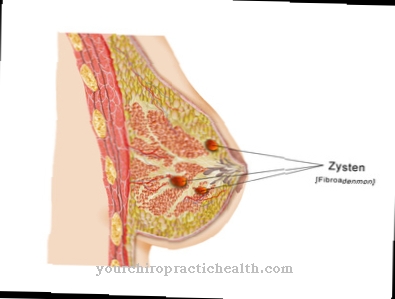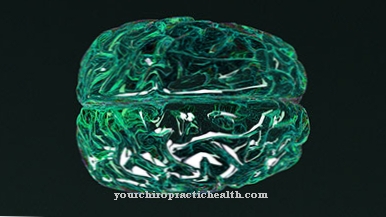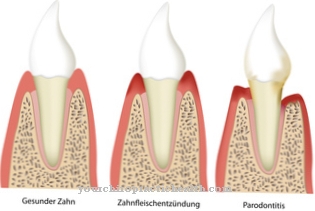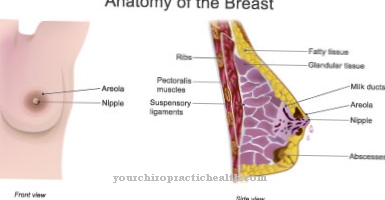Of the Rinne attempt is a subjective, non-invasive and quickly performed ENT test that uses a vibrating tuning fork to compare the bone conduction and air conduction of an ear.
The test procedure allows differential diagnostic statements to be made on the type of hearing loss, which in particular allow a distinction to be made between sensorineural and conductive hearing loss. Since the Rinne test is a subjective test procedure, the patient must be willing to cooperate and should also be able to understand the test and the instructions of the test staff without restrictions.
What is the gutter attempt?

The Rinne test is a subjective test from ear, nose and throat medicine. Heinrich Adolf Rinne first described the procedure in 1855. As with the Weber test and the Bing test, the Rinne test is also a tuning fork test. The air conduction and the bone conduction of sound are compared with each other, which, in combination with the results of the Weber test, enables the hearing impairment to be assigned.
Usually the Weber attempt precedes the Rinne attempt. However, the two procedures can also be used in reverse order. The clinically oriented test run of the Rinne experiment works on the physiological properties of the ear and thus serves to diagnose sound sensation or sound conduction disorders. Each ear is tested individually. If the Weber test previously revealed unilateral hearing loss, the Rinne test is generally only carried out on one ear.
Function, effect & goals
Together with the Weber experiment, the Rinne experiment is now the standardized method for examining hearing disorders. The test procedure can be used for both unilateral and bilateral hearing loss. Because the Rinne test makes it possible to differentiate between sensorineural and conductive hearing loss, the method is primarily of importance for differential diagnosis.
Every ENT practice is able to carry out the test procedure. A tuning fork is set in motion in preparation for the test procedure. The performing staff then place the vibrating foot of the tuning fork on the mastoid process. This is a bone conduction that is responsible for the transfer of sound sensations and is located as a bone process behind each auricle.
The patient now hears a tone through the vibrations of the tuning fork. The implementing staff asks him to notify him if the sound has fallen silent. After the subjectively perceived silence on the bone conduction behind the ear, the tuning fork is now held on the air conduction in front of the ear. The instrument is not struck again for this purpose. Usually the ossicles and eardrum amplify the sound on the air duct in front of the auricle.
A patient with normal hearing therefore hears the sound that has been silenced on the bone conduction on the air conduit in front of the ear as soon as the tuning fork is in front of the auricle. The air conduction of a healthy patient naturally reproduces the sound in the ear canals longer than the mastoid process of the bone conduction. The Rinne attempt is rated as positive if the patient hears the sound again via the air line. If he can no longer hear it in front of the auricle, the result of the test is considered negative.
In the case of conductive hearing loss, the patient hears the tone of the tuning fork over the bone conduction louder and longer than over the air conduction. A negative Rinne test can therefore indicate conductive hearing loss. If, on the other hand, there is sensorineural hearing loss, the patient hardly hears the sound either via the bone conduction or via the air conduction. In the case of sensorineural hearing loss, the sound perception via the air conduction is never worse than the perception via the bone conduction.
You can find your medication here
➔ Medicines for earache and inflammationRisks, side effects & dangers
Since the Rinne test is a subjective hearing test, the procedure is not necessarily suitable for every patient. The Rinne experiment can lead to incorrect results in children and mentally handicapped people.
The subjective feeling and the cooperation of the patient are the focus of the test procedure. The personnel carrying out the work can only assess with difficulty to what extent the statements made about the sound perception correspond to the truth. Therefore, the Rinne test is just as unsuitable for unwilling patients as other hearing tests from the group of subjective test procedures.
In particular, if the results of the Weber and Rinne experiments are contradictory, the test staff may, under certain circumstances, question the patient's cooperation or suspect that the test person was incorrectly perceived as originally. Neither the Weber test nor the Rinne test is associated with effort for the patient. The Rinne test is actually one of the fastest ENT test tests that can be carried out. Since the test run is a non-invasive procedure, the patient does not have to be hospitalized or observe special rules of conduct prior to the procedure. There are no risks or side effects in the Rinne attempt. At most, a slight ringing in the ears occurs temporarily.
As a rule, the Rinne test is never carried out independently, but always in combination with the Weber test, which is just as easy to carry out and just like the Rinne test does not involve any risks or side effects. In the Weber experiment, too, a tuning fork is made to vibrate and is placed on the subject's head. For people with normal hearing, the sound is transmitted in phase to both inner ears via the bone conduction. Deviating results indicate a one-sided or asymmetrical hearing impairment, which can be determined more precisely using the Rinne experiment.








.jpg)







.jpg)



.jpg)







